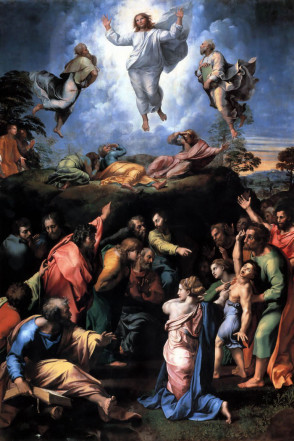Beethoven Symphony Basics at ESM
Symphony No. 5 in C minor, Op. 67 (1808)
The Basics
General Information
Composition dates: 1804-05, 1807-08; sketches 1805 (set aside for Sym. No. 4).
Dedication: Prince Joseph Franz Maximilian Lobkowitz (also Wikipedia, and portrait) and Count Andrey Razumovsky (also Wikipedia, and portrait). Same dedicatees as Symphony No. 6.
Instrumentation (IV=added mvt. IV): Strings, PicIV, 2 Fl, 2 Ob, 2 Cl, 2 Bsn, CBsnIV, 2 Hn, 2 Tr, ATBTbnIV, Timp.
First performance: 22 December 1808, Akademie at Theater-an-der-Wien. (Also Sym. No. 6.)
Orchestra size for first or early performance: 12-16.3-4.3-4.3-5/single winds.
Autograph Score: Staatsbibliothek, Berlin. Image available online.
First published parts: April 1809, Breitkopf und Härtel, Vienna. Image available at IMSLP and Beethoven-Haus.
First published score: May 1826, Breitkopf und Härtel, Vienna. Image available at Beethoven-Haus. (Cohn)
Movements (Tempos. Keys. Forms.)
I. Allegro con brio (MM=108). C Minor. Sonata-Allegro.
II.Andante con moto (MM=92). A-flat major (VI). Theme & Variation with a development.
III. Scherzo. Allegro (MM=96). C Minor/Major. Scherzo/Trio (ternary). Attacca to:
IV. Finale. Allegro (MM=84). C Major. Sonata-allegro.
Significance and Structure
In his epochal review of Beethoven’s Symphony No. 5 in C minor, Op. 67, E. T. A. Hoffman praised it as “one of the most important works of the time.” Its famous four-note opening gesture is not only credited as, “Fate knocks at the door” by Beethoven’s factotum and biographer Anton Schindler, but also represents the “fate” that Beethoven wants to overcome during his lifetime, because he was experiencing an increasing deafness, psychic pain and depression. Beethoven wrote in a letter: “I will seize fate by the throat; it shall certainly not bend and crush me completely” (Lockwood, Beethoven Symphonies, 95). One of the aspects that makes the Fifth Symphony remarkable is that the “fate motif” is not treated as simply a first theme. Instead, Beethoven put it throughout the entire piece—an obsessive repetition of the motif at different pitch levels, combined with interruptive stops that fight its restless momentum. (Lewanski, Beethoven and the Romantic Sublime.) Indeed, the “fate motif” is the most essential element of this symphony but it is not the only thing that makes the Fifth Symphony great.
Beethoven started to sketch the Fifth Symphony in 1804, almost immediately following the completion of Symphony No. 3, Eroica, but the composing progress was interrupted by several works such as Fidelio, the three Razumovsky string quartets, and the Appassionata piano sonata. Beethoven finally completed the Fifth Symphony in 1808. It received its public premiere in December of that year, along with the Sixth Symphony, Fourth Piano Concerto, Choral Fantasy, “Gloria” from the Mass in C, and a piano improvisation by Beethoven. During the long four-year period of composition Beethoven broke convention on several aspects. Most particularly, it was the first symphony that Beethoven wrote in a minor key—C minor. Minor-keyed symphonies were not unheard of, but were not the norm at the time. Mozart only composed two minor-mode symphonies, Nos. 25 and 40, both in G minor. The Eroica sketchbook shows a connection between the finale of No. 40 and the scherzo of the Fifth Symphony. (Lockwood, Beethoven’s Symphonies, 97.) Only ten of Haydn’s over 100 symphonies were minor, most of them during his Sturm und Drang years 168-72. Of Haydn’s late symphonies, which would have been known to Beethoven, only one of the “Paris” (No. 83 in G minor) and one of the “London” symphonies, Symphony No. 95, is in minor. The latter may have influenced Beethoven’s choice of C minor, but this was a key of special importance to Beethoven. Charles Rosen was one of many commentators on Beethoven’s “C-minor mood,” stating,
Beethoven in C minor has come to symbolize his artistic character. In every case, it reveals Beethoven as Hero. C minor does not show Beethoven at his most subtle, but it does give him to us in his most extroverted form, where he seems to be most impatient of any compromise. (Rosen, Beethoven’s Piano Sonatas, 134.)
The similar “heroic character” can be perceived in his other C minor multi-movement works, such as the Piano Sonata No. 8, “Pathetique”, String Quartet, Op. 18, no. 4, Piano Concerto No. 3, Op. 37, and his last Piano Sonata, Op. 111.
Secondly, Beethoven experiments with different balances and goals of the symphonic cycle. For example, in the first movement, Beethoven gave essentially equal length to all four sections of the sonata form—exposition, development, recapitulation, coda—creating structural balance. Unlike codas in Classical symphonies, where the goal was to come to a quick conclusion, here the coda is lengthy and unstable, proceeding as a second development section. Furthermore, where the exposition presented an E-flat major horn call followed by other major themes, suggesting the problem will be solved in favor of C major in the recapitulation, the recapitulation weakens the solution by using the milder-toned bassoons for the horn call rather than asking the E-flat horns to change to C crooks, and, the C major closing theme is smashed by an insistent C-minor shift that remains for the entire, lengthy coda.
The enhancement of compositional weightiness of third and fourth movements emphasized Beethoven’s emerging ideal of the movement cycle conveying a teleological outlook related to the Bildungsroman, a Heroic or developmental novel that reemerged in the late eighteenth and early nineteenth centuries. Beethoven’s “fate motif” development and transformation from the first movement to the end of the third movement and finally released in the finale certainly conveys the heroic ideal. Bringing it to a fulfilling conclusion, Beethoven connected the last two movements with an astonishing transition that generated enormous anticipation, with a gradual crescendo and additive instrumentation over insistent timpani finally bursting without pause into the blazing, victorious finale. The attacca idea may have come from the fantasia genre—a freely developed sectional form as understood in the late eighteenth century. The fantasia certainly influenced the episodic finale of the Eroica Symphony, as well as his Piano Fantasy, Op. 77 and Choral Fantasy, Op. 80, written at the same time. (Lockwood, Beethoven Symphonies, 113.)
Finally, the innovative application of instruments, particularly in the victorious finale, confirmed the status of the Fifth Symphony. Trombones, contrabassoon and piccolo suddenly appeared at the last movement, enriching the sound and impact of the orchestra—it gets higher, lower, and louder. It was the first time that these instruments had been used together in a symphonic work, and these instruments carried with them suggestion of military and sacred topoi. (This is discussed in detail in the essay “Beethoven’s Words” below. The ascending major triads played by the trombones at the finale’s opening displayed a march-like phrase in C major, along with the piccolo and contrabassoon, would be reminiscent of French overture/military music, and the alto, tenor, and bass trombone trio was connected to the sacred music tradition. All of this innovation stresses the sublime aesthetic, with a sense of triumph similar to that achieved in the “Hallelujah” of Beethoven’s oratorio Christ on the Mount of Olives, Op. 85, composed at about the same time. (One can note the similarities of this and Beethoven’s Military Band in D, WoO 24, written in 1816.)
[We refer the reader to the following video performance for the ensuing discussion: Gardiner conducts Orchestre Révolutionnaire et Romantique.]
The first movement begins with the characteristic “fate motive” (0:00-0:07). Instead of the usual more melodic opening themes, the work commences with a dark and rhythmically varied theme; and dramatic the fermatas. After the initial statement, the “drama-proper” begins with a series of urgent fate motives, played piano and imitated in the strings, before quickly reaching an outburst of tutti forte texture, where it finally develops beyond the initial motive, arriving at another fermata. The rhythmic pulse of the fate motive pushes the story forward, creating a sense of urgency and inevitability. Virtually every measure of the symphony uses the fate motive in some form; it is short and tight in construction. One of the hallmarks of Romanticism was indeed the conflict between the individual hero and larger forces, as the ubiquity of the fate motive surrounded by new materials suggests. A sense of rising above the struggle is given by an E-flat-major horn call (1:58-2:01) and dolce, hopeful, pastoral second theme in the strings (2:01-2:18), followed by a return to the original motive now in E-flat major (2:26-2:35) to close the exposition.
In the development (2:36-3:50) a sense of teleology is achieved despite a relatively limited set of keys and themes. Harmony is not the driving force, but rather texture, orchestral color, and dynamics. For example, at the end of the development (3:18-3:50) the material is reduced from four voices to one voice, and the main motive is reduced to just two- and then one-note conversations between strings and winds. The recapitulation (3:50-5:17) begins suddenly, with the dormant feeling of the previous section bursting back into a thickened texture; the fate motive was waiting all along to violently re-emerge! A brief respite from its violence is achieved by a plaintive oboe solo (4:06-4:18), but this respite is only temporary. The promise of relief suggested by the C-major restatement of the E-flat themes from the exposition is thwarted by a sudden, sublime forcing of C minor to begin a long, developmental coda (5:18-6:40) which ends in the same manner the whole movement began. Heroic overcoming is saved for later. With all of the force, storminess, and twists contained in this movement, it is all the more astounding that Beethoven nearly perfectly balanced the four parts of the form—exposition development, recapitulation, coda—with each section being between 123 and 129 measures.
The second movement (6:47-15:22) offers relief from the previous movement’s incessant intensity and unfulfilled ending. It begins piano with a noble, restrained theme in A-flat in the lower strings (6:47-7:40), before bursting into a brief forte contrasting C-major militaristic theme, featuring trumpets and timpani (7:52-8:14). The two main key centers of A-flat and C mirror the first movement in which our hero was caught between two exaggerated worlds—that of the C minor fate motive and the E-flat major hopeful theme. The A-flat major section returns for a first variation, emphasizing the woodwind Harmoniemusik texture, before again giving way to the C-major theme. After a brief A-flat minor passage (12:34-13:00),the first theme, once small and humble, returns regal and triumphant in a tutti, legato, and fortissimo texture (13:05-13:26); this is the first real moment in the symphony in which a sense of emotional reassurance has occurred. Furthermore, this and subsequent variations will include only the A-flat theme, not the militaristic C-major theme. As with the first movement, once again the victorious C major goal is promised, but unfulfilled. This movement, like many second movements in minor-key symphonies, gives a sense of respite and calm before the return of the storm.
The third movement (15:28-22:49) begins with mystery (15:28-15:48) in the low strings (as the second movement had begun), followed by the movement’s main idea: the horns blast a call to action (15:48-15:54) consisting of the original short-short-short-long rhythmic motive, clearly related to the fate motive of the first movement. Beethoven’s sketches show that the first and third movements were the two first conceived. (Lockwood, Beethoven’s Symphonies, 100.) Although the movement does not bear the title “scherzo” (only the tempo marking “allegro” is given in the score), all of the elements of a Beethoven scherzo are present: the tempo is quick, misplaced accents, and changing, unbalanced phrase lengths throughout. From a formal standpoint, this movement follows the structural models of the dance movements of the past, but the earliest manuscripts show that Beethoven originally intended for it to be in five parts, as he did in the scherzo movement in the Fourth Symphony. By the first publication of the parts in 1809, however, Beethoven shortened the scherzo into three parts, without full repeats of the scherzo-trio before the final re-written scherzo bridge to the finale. (Note: the full five-part form of the earliest performances is followed in the video performance referred to in this discussion.) The most notable aspect of the scherzo comes in the trio (17:05-18:20), where instead of the usual pastoral character with emphasis on the winds, Beethoven provided a bright and energetic fugue in C major, continuing the narrative between C minor and C major that has been present throughout the symphony. The use of a fugue not only pushes forward the excitement and tension, it also suggests a sacred topic in a musical section that is traditionally very secular, even rustic, giving the third movement a surprising seriousness that, in turn adds weight and importance. This teleological approach is only intensified by the return of a hushed, anticipatory re-writing of the scherzo, as the short-short-short-long fanfare theme is played by solo woodwinds and pizzicato strings (21:32-22:02) and the motive continues subtly in timpani (22:17-22:20), as if to remind us that the battle is not over, and something is yet to come. This serves as a bridge to the finale.
George Grove characterizes the tension building bridge passage of the scherzo (22:27-22:49) leading to the victorious (finally!) C-major finale movement (22:49-end) this way: “To hear it is like being present at the work of Creation.” (Grove, Beethoven and His Nine Symphonies, 172.) During the bridge, the violins climb slowly out of C minor by an almost imperceptive E-natural of C major, leading to a crescendo and gradual addition of all of the instruments, finally launching into the fourth movement without a pause. The element of victory that is so often tied to the Fifth Symphony must surely come from this moment: the triumphant march presented by the full orchestra, now complete with piccolo, contrabassoon, and three trombones, seems to declare, if not outright celebrates the assertion of C major over C minor. There are four new themes presented in the exposition of the fourth movement, all of which are presented in a major key and have connections to material presented throughout the previous three movements. The third (23:47-24:13) and fourth (24:13-24:35) themes both feature the short-short-short-long motive. However, a literal recall of substantial thematic material, rather than just the pervasive motive, comes in the development (26:33-28:45), when Beethoven returns to the material of the scherzo and bridge and with it the key of C minor (28:15-28:45). This recall has become “one of the most famous moments in symphonic literature”, and even critics of the Fifth Symphony conceded that it was an act of genius. (Lockwood, Beethoven’s Symphonies, 113.) Not only does it further serve Beethoven’s cyclical integration of all four movements, but it also extends the hero’s narrative; by bringing back the key of C minor and reminding us of the struggles previously heard, Beethoven allows for an even greater sense of victory and overcoming in the recapitulation (28:45-31:07), in which all four themes come back relentlessly in the key of C major. The coda (31:07-end) that follows is one of the longest Beethoven ever wrote and remains in the key of C major the entire time; in fact, after the brief return of the scherzo, the piece remains in C major until the end. The second part of the coda (32:06-end) is marked by an increase in tempo: we hear the fourth theme, but hidden within the repetitions of this motive is also the rising triadic first theme! The tempo increases, and Beethoven is seemingly pushing us to the end, hammering the tonic C-major chord over and over again at the end until the entire orchestra finally plays a unison C in the final bar. Per ardua ad astra, through struggle to the stars, our hero’s journey ends in victory.
—Contributors: EH, SH, ST, SY, MER
Beethoven’s Words
“The last movement in the symphony is with 3 trombones and flautini [piccolos]—though not with 3 kettledrums, but will make more noise than 6 kettledrums and better noise at that-.” Letter written to Count Franz von Oppersdorff, March, 1808. (Thayer, Thayer’s Life of Beethoven, Vol. 1., 433.)
Beethoven’s quote suggests that he and Count Oppersdorff had previous correspondence on the instrumentation necessary to “make more noise” in the finale of the Fifth Symphony. The decision to delay the entrance of piccolo, contrabassoon and trombones until the final movement allows the finale to burst forth in an overwhelming exclamation of joy, sweeping away the ominous presence of the previous three movements. These particular instruments also change the entire soundscape of the orchestra by opening up its range, both an entire octave higher (piccolo) and lower (contrabassoon) in the woodwinds, increasing the volume dramatically with three trombones, and giving it a military band character. Their inclusion changes the foreboding march of “Fate” into a triumphal and enthusiastic anthem of victory for the finale.
Beethoven’s desire to arrive at the military sound of a march in the finale of his Fifth Symphony could partly be due to a rise of local patriotism from Germany and Austria’s repeated losses to France. In 1807, a large part of Germany was lost to the French with the Treaty of Tilsit and Beethoven’s own anti-French sentiments were at an all-time high. He remarked to a friend at this time, “I too would like to . . . drive them away from where they have no right to be.” (Solomon, Beethoven, 264.) He also exclaimed to the violinist Krumpholz, “Pity that I do not understand the art of war as well as I do the art of music; I should yet conquer Napoleon!”, after learning of Napoleon’s victory at Jena (Kerst & Krehbiel, “Beethoven: The Man and the Artist, As Revealed in his own Words,” n. 161).
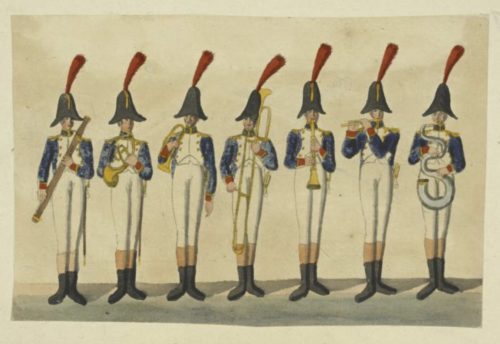
To Beethoven and his audience in 1808, the piccolo was a standard instrument for a marching band, but virtually unknown in symphonic compositions. See the image above depicting a French military band ca. 1806. Beethoven was the first composer to include the piccolo in symphonic works. (Teng, Kuo-Jen.“The Role of the Piccolo in Beethoven’s Orchestration,” 3.) When he did use it, it was sparingly and always associated with military/soldierly topics, such as the triumphal finale of the Fifth Symphony, the Turkish March in the finale of the Ninth Symphony, and the coda of the Overture to Egmont, Op. 84. At one other time, in the thunderstorm of the Sixth Symphony, the piccolo imitates the whistling of the wind. The contrabassoon was probably a familiar sound in symphonic compositions, as evidence suggests it was likely used at times, in large orchestras, to double the sound of the violones/double basses. But its distinctive deep and reedy sound could also be heard in military bands. Beethoven used piccolo and contrabassoon for his own marches for military band marches, such as his “Für die Böhmische Landwehr” (“For the Bohemian Ward”), WoO 18 (1809) which is scored for piccolo, contrabassoon, 2 flutes, 3 clarinets (C & F), 2 trumpets, 2 french horns, 2 bassoons and percussion, and “Pferde Musik” (“Horse-music”), WoO 19 (1810) scored for piccolo, contrabassoon, 2 flutes, 3 clarinets (C & F), 2 trumpets, 2 french horns, 2 bassoons and percussion. The march-like rhythms and the use of characteristic marching band instruments in the finale helps to emphasize the sense of a triumphal victory after a great struggle.
The three-trombone choir—alto, tenor and bass—similarly carried specific topical connotations based on their historical use as doubling choral parts in sacred vocal music. For centuries this type of trombone choir was virtually synonymous with sacred music, particularly in the German-speaking world. Some of Beethoven’s contemporaries in Vienna who had recently written religious works using that same trombone choir to double the chorus, including Antonin Reicha’s (teacher of Liszt, Berlioz, and Franck) Missa pro defunctis (1803-09), and Antonio Salieri’s (teacher of Beethoven, Schubert and Liszt) Requiem in C minor (1804). (See Trombone History: 19th Century.)
By understanding the vocal-like history of the trombone choir, it becomes especially interesting to note how Beethoven used the trombones in the Fifth Symphony. After the march-like opening theme, instead of matching the marching rhythms played by the rest of the orchestra, the trombones sing forth their parts in a choir-like manner through the emphasis of long powerful chords and dramatic entrances. This unique vocal choir use of the trombones could possibly be the germination of Beethoven’s revolutionary idea to use a vocal choir in his Ninth Symphony.
Besides the abundance of march music and Beethoven’s own use of piccolo and contrabassoon in his works for military band, and the plethora of sacred music using the three-trombone choir, many operas of the late eighteenth century also used these instruments for topical scenic enhancement. Notably, Mozart’s Idomeneo, Don Giovanni, and Die Zauberflöte all include the alto-tenor-bass trombone trio in scenes depicting supernatural elements. The Fifth Symphony’s unprecedented instrumentation in the final movement effectively changes the bright and boisterous march into a militaristic anthem of victory, but, as in the great heroic stories of the middle ages, there is a religious side to these stories as well, with the salvation of the hero being part of his journey. So Beethoven, as was his genius, uses instrumentation as one of the tools that brings the symphonic genre ever closer to bona fide dramatic works, and though the Fifth Symphony does not celebrate any particular country or individual, it celebrates the power of overcoming and the victory of the self, and the soul.
—Contributors: FJ, JM, MER
Others’ Words
E. T. A. Hoffmann was one of the most influential and creative writers of the early nineteenth century whose literature often emphasized and critiqued romantic aesthetic values. A versatile artist, he was also a music critic, lawyer, composer, conductor, musician, and painter. Among his many submissions to the Allgemeine musikalisches Zeitung include “Beethoven’s Instrumental Music” of 1810, revised in 1813 as part of the collection Kreisleriana. (Here is an article about it by Arthur Ware Locke from Musical Quarterly in 1917, with a translation of the text.) In this widely quoted critical essay, Hoffmann commends Beethoven’s Symphony No. 5 and instrumental music more generally as model vehicles for deep and powerful emotional expressivity, and therefore the summit of Romantic arts. The following translated excerpts compare Beethoven’s music to Haydn’s and Mozart’s, and give a colorful description of Beethoven’s Fifth Symphony. In the spirit of the multi-sensory nature of Hoffmann’s works, we have provided paintings (which are linked to information) and links to musical examples that illustrate Hoffmann’s points, details, and description.
On Haydn, Mozart, and Beethoven:
“Mozart and Haydn, the creators of the instrumental music of today, show us the art for the first time in its full glory; the one who has looked on it with an all-embracing love and penetrated its inmost being is—Beethoven! The instrumental compositions of all three 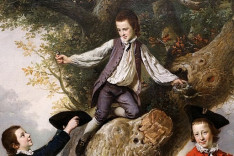 masters breathe the same romantic spirit, which lies in a similar deep understanding of the essential property of the art; there is nevertheless a decided difference in the character of their compositions. The expression of a child-like joyous spirit predominates in those of Haydn. His symphonies lead us through boundless green woods, among a merry, gay crowd of happy people. Young men and maidens pass by dancing; laughing children peeping from behind trees and rose-bushes playfully throw flowers at one another.
masters breathe the same romantic spirit, which lies in a similar deep understanding of the essential property of the art; there is nevertheless a decided difference in the character of their compositions. The expression of a child-like joyous spirit predominates in those of Haydn. His symphonies lead us through boundless green woods, among a merry, gay crowd of happy people. Young men and maidens pass by dancing; laughing children peeping from behind trees and rose-bushes playfully throw flowers at one another.
 “A life full of love, of felicity, eternally young, as before the fall; no suffering, no sorrow, only a sweet melancholy longing for the beloved form that floats in the distance in the glow of the sunset, neither approaching nor vanishing, and as long as it is there night will not come for it is itself the evening glow which shines over mountain and wood.
“A life full of love, of felicity, eternally young, as before the fall; no suffering, no sorrow, only a sweet melancholy longing for the beloved form that floats in the distance in the glow of the sunset, neither approaching nor vanishing, and as long as it is there night will not come for it is itself the evening glow which shines over mountain and wood.
 “Mozart leads us into the depths of the spirit world. We are seized by a sort of gentle fear which is really only the presentiment of the infinite. Love and melancholy sound in the pure spirit voices; night vanishes in a bright purple glow and with inexpressible longing we follow the forms which, with friendly gestures, invite us into their ranks as they fly through the clouds in the never-ending dance of the spheres.
“Mozart leads us into the depths of the spirit world. We are seized by a sort of gentle fear which is really only the presentiment of the infinite. Love and melancholy sound in the pure spirit voices; night vanishes in a bright purple glow and with inexpressible longing we follow the forms which, with friendly gestures, invite us into their ranks as they fly through the clouds in the never-ending dance of the spheres. 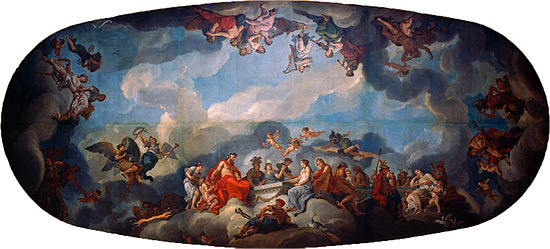
“In the same way Beethoven’s instrumental music discloses to us the realm of the tragic and the illimitable.  Glowing beams pierce the deep night of this realm and we are conscious of gigantic shadows which, alternately increasing and decreasing, close in on us nearer and nearer, destroying us but not destroying the pain of endless longing in which is engulfed and lost every passion aroused by the exulting sounds. And only through this very pain in which love, hope, and joy, consumed but not destroyed,
Glowing beams pierce the deep night of this realm and we are conscious of gigantic shadows which, alternately increasing and decreasing, close in on us nearer and nearer, destroying us but not destroying the pain of endless longing in which is engulfed and lost every passion aroused by the exulting sounds. And only through this very pain in which love, hope, and joy, consumed but not destroyed, ![]() burst forth from our hearts in the deep-voiced harmony of all the passions, do we go on living and become hypnotized seers of visions!
burst forth from our hearts in the deep-voiced harmony of all the passions, do we go on living and become hypnotized seers of visions!
An appreciation of romantic qualities in art is uncommon; romantic talent is still rarer. Consequently there are few indeed who are able to play on that lyre the tones of which unfold the wonderful region of romanticism.
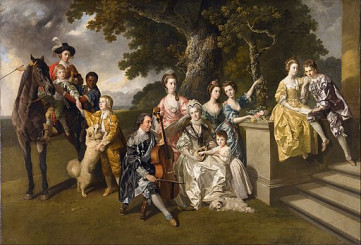 “Haydn conceives romantically that which is distinctly human in the life of man; he is, in so far, more comprehensible to the majority.
“Haydn conceives romantically that which is distinctly human in the life of man; he is, in so far, more comprehensible to the majority.
Mozart grasps more the superhuman, the miraculous, which dwells in the imagination.
Beethoven’s music stirs the mists of fear, of horror, of terror, of grief, and awakens that  endless longing which is the very essence of romanticism. He is consequently a purely romantic composer, and is it not possible that for this very reason he is less successful in vocal music which does not surrender itself to the characterization of indefinite emotions but portrays effects specified by the words rather than those indefinite emotions experienced in the realm of the infinite?”
endless longing which is the very essence of romanticism. He is consequently a purely romantic composer, and is it not possible that for this very reason he is less successful in vocal music which does not surrender itself to the characterization of indefinite emotions but portrays effects specified by the words rather than those indefinite emotions experienced in the realm of the infinite?”
On Symphony No. 5:
“What instrumental work of Beethoven testifies to this to a higher degree than the immeasurably noble and profound Symphony in C minor? How this marvelous composition carries the hearer irresistibly with it in its ever-mounting climax into the spirit kingdom of the infinite! What could be simpler than the main motive of the first allegro composed of a mere rhythmic figure which, beginning in unison, does not even indicate the key to the listener. The character of anxious, restless longing which this portion carries with it only brings out more clearly the melodiousness of the second theme!—It appears as if the breast, burdened and oppressed by the premonition of tragedy, of threatening annihilation, in gasping tones was struggling with all its strength for air; but soon a friendly form draws near and lightens the gruesome night. . . . How simple—let us repeat once more—is the theme which the master has made the basis of the whole work, but how marvelously all the subordinate themes and bridge passages relate themselves rhythmically to it, so that they continually serve to disclose more and more the character of the allegro indicated by the leading motive. All the themes are short, nearly all consisting of only two or three measures, and besides that they are allotted with increasing variety first to the wind and then to the stringed instruments. One would think that something disjointed and confused would result from such elements; but, on the contrary, this very organization of the whole work as well as the constant reappearances of the motives and harmonic effects, following closely on one another, intensify to the highest degree that feeling of inexpressible longing. Aside from the fact that the contrapuntal treatment testifies to a thorough study of the art, the connecting links, the constant allusions to the main theme, demonstrate how the great Master had conceived the whole and planned it with all its emotional forces in mind.
“Does not the lovely theme of the Andante con moto in A-flat sound like a pure spirit voice which fills our souls with hope and comfort?—But here also that terrible phantom which alarmed and possessed our souls in the Allegro instantly steps forth to threaten us from the thunderclouds into which it had disappeared, and the friendly forms which surrounded us flee quickly before the lightning.
“What shall I say of the Minuet? Notice the originality of the modulations, the cadences on the dominant major chord which the bass takes up as the tonic of the continuing theme in minor—and the extension of the theme itself with the looping on of extra measures. Do you not feel again that restless, nameless longing, that premonition of the wonderful spirit-world in which the Master holds sway? But like dazzling sunlight the splendid theme of the last movement bursts forth in the exulting chorus of the full orchestra. What wonderful contrapuntal inter-weavings bind the whole together. It is possible that it may all sound simply like an inspired rhapsody to many, but surely the heart of every sensitive listener will be moved deeply and spiritually by a feeling which is none other than that nameless premonitory longing; and up to the last chord, yes, even in the moment after it is finished, he will not be able to detach himself from that wonderful imaginary world where he has been held captive by this tonal expression of sorrow and joy. In regard to the structure of the themes, their development and instrumentation, and the way they are related to one another, everything is worked out from a central point-of-view; but it is especially the inner relationship of the themes with one another which produces that unity which alone is able to hold the listener in one mood. This relationship is often quite obvious to the listener when he hears it in the combination of two themes or discovers in different themes a common bass, but a more subtle relationship, not demonstrated in this way, shows itself merely in the spiritual connection of one theme with another, and it is exactly this subtle relationship of the themes which dominates both allegros and the Minuet—and proclaims the self-conscious genius of the Master.”
—Contributors: AL, LB, YLi, MER
Topics and readings for further inquiry
Regional History (1806)
General Research Division, The New York Public Library. “France, 1806” New York Public Library Digital Collections. Accessed July 20, 2020.
Hicks, Peter, “Why did the battle of Jena take place?” Napoleon.org.
A great overview of the political and militaries issues leading up to the battle of Jena.
Beethoven in his own words
Kerst, Friedrich and Krehbiel, Henry Edward, “Beethoven: The Man and the Artist, As Revealed in his own Words.”
A collection of various quotes and writings by Beethoven, organized into various topics regarding his views: on composing, on performing music, on his own works, etc.
Beethoven and Schindler
Albrecht, Theodore.”.Anton Schindler as destroyer and forger of Beethoven’s conversation books: A case for decriminalization.” Music’s intellectual history (2009): 169-82. Available online at rilm.org.
Roles of Piccolo and Trombone in symphonic music
Kimball, Will. “Trombone History: 19th Century (1801-1825).” kimballtrombone.com.
A very extensive and well researched website on the history and usage of the trombone. Page hosted by trombonist Will Kimball.
Teng, Kuo-Jen. “The Role of the Piccolo in Beethoven’s Orchestration.” DMA dissertation. Digital Library UNT.
A doctoral dissertation on the role of the piccolo in Beethoven’s symphonic works.
On Fate and musical meaning
Guerrieri, Matthew. The First Four Notes: Beethoven’s Fifth and the Human Imagination. New York: Vintage Books, 2014.
Guerrieri goes through the many musical and extra-musical associations of Beethoven’s opening motive, bringing in history, philosophy, art, and social theory into a multi-dimensional exploration of this famous musical moment.
“Beethoven’s Fifth Symphony: the Truth About the ‘Symphony of Fate’”. Deustch Welle. Accessed 07/20/2020.
Beethoven, Romanticism, the Sublime, E.T.A. Hoffmann
Lewanski, Michael. “Beethoven and the Romantic Sublime: The Fifth Symphony.” www.michaellewanski.com. Accessed 07/24/2020.
Beethoven and the “C-minor Mood”
“Beethoven and C minor.” Wikiwand. Accessed 07/25/2020
Rosen, Charles. Beethoven’s Piano Sonatas: A Short Companion. New Haven: Yale University Press, 2002.
Online Resources
Early Editions of Score and Parts
Autograph score
First Complete Scholar Edition. Ludwig van Beethovens Werke, Serie 1: Symphonien, Nr.5.Leipzig: Breitkopf und Härtel, n.d.[1862]. Plate B.5.
Parts: First Edition. Leipzig: Breitkopf und Härtel, n.d.[1809]. Plate 1329.
Modern Edition of the Score
1989 Dover Edition. Reprint of the Braunschweig: Henry Litolff’s Verlag, No. 2769, n.d. (ca.1880)
1976 Dover Edition (Reprint of the edition by Leipzig: Ernst Eulenburg, n.d. [1938])
New York Philharmonic score with annotations by Leonard Bernstein.
New York Philharmonic score with annotations by Artur Rodzinski.
New York Philharmonic score with annotations by Erich Leinsdorf.
Recordings available online
Period/HIP Performances—
Orchestre Révolutionnaire et Romantique, Gardiner
1st movement, 2nd movement, 3rd movement, 4th movement
Video: Gardiner conducts Orchestre Révolutionnaire et Romantique.
Hanover Band, Goodman and Huggett
1st movement, 2nd movement, 3rd movement, 4th movement
The first complete set of the Nine Symphonies to be issued on original instruments.
The London Classical Players, Norrington
1st movement, 2nd movement, 3rd movement, 4th movement
Among the earliest complete set of the Nine Symphonies issued on original instruments, recorded in the late-1980s, several years after Hanover Band’s recording.
MusicAeterna, Currentzis
1st movement, 2nd movement, 3rd movement, 4th movement
Every musical gesture is exaggeratedly interpreted, full of Currentzis’s personality, a transcendent recording.
Concentus Musicus Wien, Harnoncourt
1st movement, 2nd movement, 3rd movement, 4th movement
One of the final recordings of the maestro. Different than the complete symphony set with Europe Chamber Orchestra.
Orchestra of the 18th Century, Brüggen
1st movement, 2nd movement, 3rd movement, 4th movement
Complete Set of Beethoven Symphonies by Orchestra of the 18th Century and Brüggen
Important Recordings by Modern Orchestras—
London Philharmonic Orchestra, Weingartner
1st movement, 2nd movement, 3rd and 4th movements
One of the earliest commercial recordings in history of Beethoven Fifth Symphony.
Philharmonic Orchestra, Klemperer
1st movement, 2nd movement, 3rd movement, 4th movement
Typical mid 20th-century interpretation with heavy sound and slow tempo.
Vienna Philharmonic Orchestra, Rattle
1st movement, 2nd movement, 3rd movement, 4th movement
VPO’s not-so-common historically informed interpretation, with Simon Rattle talking about this symphony at the beginning of the video.
Vienna Philharmonic Orchestra, Thielemann
1st movement, 2nd movement, 3rd movement, 4th movement
Probably VPO’s most important Beethoven symphonies cycle during the first 20 years of the new century. Representative interpretation of the so-called German-Austrian tradition.
Vienna Philharmonic Orchestra, Kleiber
1st movement, 2nd movement, 3rd movement, 4th movement
One of the most famous Beethoven Fifth Symphony recordings that Deutsche Grammophon has ever issued and one of the very few commercial recordings by Carlos Kleiber the legend.
Tonhalle-Orchester Zürich, Zinman
1st movement, 2nd movement, 3rd movement, 4th movement
Tonhalle-Orchester Zuürich is a modern orchestra, but Zinman persuades them to make a transparent sound which sounds like a period instrument ensemble.
Royal Flemish Philharmonic Orchestra, Herreweghe
1st movement, 2nd movement, 3rd movement, 4th movement
Complete Set of Beethoven Symphonies by RFRO and Herreweghe
Modern orchestra led by one of the most important early music experts of our time.
Descriptions available online (videos, program notes, etc.,)
Roger Norrington talks about Beethoven Fifth Symphony
In German.
Beethoven Fifth Symphony: Analysis by Gerard Schwarz
Symphony No. 5: Subversive subtexts | Gardiner and the ORR on Beethoven’s Symphonies
Graphic score, for site visitors who do not read music.
1st movement, 2nd movement, 3rd movement, 4th movement
How a Great Symphony was Written
Leonard Bernstein’s famous discussion of Beethoven’s Fifth Symphony, first movement compositional process, available on youtube.
Rehearsal, Chamber Orchestra of Europe with N. Harnoncourt.
Includes discussion of sources, performance considerations.
Marianne Williams Tobias, Program notes, Indianapolis Symphony.
P.D.Q. Bach (Peter Schickele) – “New horizons in music appreciation” (Beethoven)
A comical analysis of the first movement of the Fifth Symphony by Peter Schickele.


